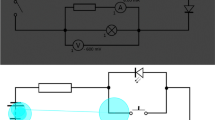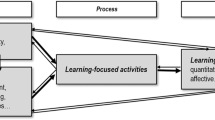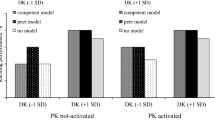Abstract
Eye movement modeling examples (EMME) are novel types of video modeling examples that contain additional eye-movement recordings of the model to provide attentional guidance. Increasing demand in using instructional videos and interest in using eye-tracking in education makes EMME an appealing research subject. Hence, this study aims to systematically review empirical studies employed EMME to synthesize extant literature and reveal literature gaps for further studies. Thirty one peer-reviewed studies containing 37 experiments published between 2009 and 2022 were included in the analyses. The findings are summarized in three subtitles including methodological, task and design characteristics of EMME studies. Results showed that the number of EMME studies has been increased recently. EMME have been used to teach cognitive skills more frequently than perceptual skills. Also, there is no consensus about the design features of EMME. Further research especially focusing on different design features of EMME and its effects are required.



Similar content being viewed by others
Explore related subjects
Discover the latest articles, news and stories from top researchers in related subjects.Data availability
Data sharing not applicable to this article as no datasets were generated or analysed during the current study.
References
* Studies included the review
*Aalioui, L., Gouzi, F., & Tricot, A. (2022). Reducing cognitive load during video lectures in physiology with eye movement modeling and pauses: a randomized controlled study. Advances in Physiology Education, 46(2), 288-296. https://doi.org/10.1152/advan.00185.2021
*Ahmadi, N., Romoser, M., & Salmon, C. (2022). Improving the tactical scanning of student pilots: A gaze-based training intervention for transition from visual flight into instrument meteorological conditions. Applied Ergonomics, 100, 103642. https://doi.org/10.1016/j.apergo.2021.103642
Alemdag, E., & Cagiltay, K. (2018). A systematic review of eye tracking research on multimedia learning. Computers and Education, 125(June), 413–428. https://doi.org/10.1016/j.compedu.2018.06.023
*Asadi, A., Daneshfar, A., Maleki, B., & Aiken, C. A. (2023). Effects of attentional focus and gaze instruction during observational learning of a basketball free-throw. Human Movement Science, 87, 103038. https://doi.org/10.1016/j.humov.2022.103038.
Baddeley, A. (1992). Working memory. Science, 255(5044), 556–559. https://doi.org/10.1126/science.1736359
Bandura, A. (1977). Self-efficacy: Toward a unifying theory of behavioral change. Psychological Review, 84(2), 191–215. https://doi.org/10.1037/0033-295X.84.2.191
Brame, C. J. (2016). Effective educational videos: Principles and guidelines for maximizing student learning from video content. CBE Life Sciences Education, 15(4), es6. https://doi.org/10.1187/cbe.16-03-0125
*Brams, S., Ziv, G., Hooge, I. T., Levin, O., Verschakelen, J., Williams, A. M., ... & Helsen, W. F. (2021). Training focal lung pathology detection using an eye movement modeling example. Journal of Medical Imaging, 8(2), 025501.https://doi.org/10.1117/1.jmi.8.2.025501
Chandler, P., & Sweller, J. (1991). Cognitive Load Theory and the Format of Instruction. Cognition and Instruction, 8(4), 293–332. https://doi.org/10.1207/s1532690xci0804_2
Chapman, K. (2021). Characteristics of systematic reviews in the social sciences. The Journal of Academic Librarianship, 47(5), 102396. https://doi.org/10.1016/j.acalib.2021.102396
Chi, M. (2006). Laboratory Methods for Assessing Experts' and Novices' Knowledge. In K. Ericsson, N. Charness, P. Feltovich, & R. Hoffman (Eds.), The Cambridge Handbook of Expertise and Expert Performance (Cambridge Handbooks in Psychology, pp. 167–184). Cambridge: Cambridge University Press. https://doi.org/10.1017/CBO9780511816796.010
*Chisari, L. B., Mockevičiūtė, A., Ruitenburg, S. K., van Vemde, L., Kok, E. M., & van Gog, T. (2020). Effects of prior knowledge and joint attention on learning from eye movement modelling examples. Journal of Computer Assisted Learning, 1(2020), 1–11. https://doi.org/10.1111/jcal.12428
Coskun, A., & Cagiltay, K. (2022). A systematic review of eye-tracking-based research on animated multimedia learning. Journal of Computer Assisted Learning, 38(2), 581–598. https://doi.org/10.1111/jcal.12629
de Koning, B. B., Tabbers, H. K., Rikers, R. M. J. P., & Paas, F. (2010). Attention guidance in learning from a complex animation: Seeing is understanding? Learning and Instruction, 20(2), 111–122.
de Koning, B. B., Hoogerheide, V. V., & Boucheix, J.-M.J.-M. (2018). Developments and Trends in Learning with Instructional Video. Computers in Human Behavior, 89, 395–398. https://doi.org/10.1016/j.chb.2018.08.055
de Koning, B.B., Jarodzka, H. (2017). Attention Guidance Strategies for Supporting Learning from Dynamic Visualizations. In: Lowe, R., Ploetzner, R. (eds) Learning from Dynamic Visualization. Springer, Cham. https://doi.org/10.1007/978-3-319-56204-9_11
*Eder, T. F., Scheiter, K., Richter, J., Keutel, C., & Hüttig, F. (2022). I see something you do not: Eye movement modelling examples do not improve anomaly detection in interpreting medical images. Journal of Computer Assisted Learning, 38(2), 379-391. https://doi.org/10.1111/jcal.12619
Emhardt, S., Jarodzka, H., Brand-Gruwel, S., Drumm, C., & Van Gog, T. (2020). Introducing eye movement modeling examples for programming education and the role of teacher’s didactic guidance. In ACM Symposium on Eye Tracking Research and Applications Symposium (ETRA), 1–4. https://doi.org/10.1145/3379156.3391978
*Emhardt, S. N., Jarodzka, H., Brand-Gruwel, S., Drumm, C., Niehorster, D. C., & van Gog, T. (2022). What is my teacher talking about? Effects of displaying the teacher’s gaze and mouse cursor cues in video lectures on students’ learning. Journal of Cognitive Psychology, 34(7) 846–864. https://doi.org/10.1080/20445911.2022.2080831
Fiorella, L., & Mayer, R. E. (2018). What works and doesn’t work with instructional video. Computers in Human Behavior, 89, 465–470. https://doi.org/10.1016/j.chb.2018.07.015
Gagné, E. D. (1985). The Cognitive Psychology of School Learning. Little, Brown and Company.
*García, V., Amadieu, F., & Salmerón, L. (2021). Integrating digital documents by means of concept maps: testing an intervention program with eye-movements modelling examples. Heliyon, 7(12), e08607. https://doi.org/10.1016/j.heliyon.2021.e08607
Gegenfurtner, A., Lehtinen, E., & Säljö, R. (2011). Expertise differences in the comprehension of visualizations: A meta-analysis of eye-tracking research in professional domains. Educational Psychology Review, 23(4), 523–552. https://doi.org/10.1007/s10648-011-9174-7
*Gegenfurtner, A., Lehtinen, E., Jarodzka, H., & Saljo, R. (2017). Effects of eye movement modeling examples on adaptive expertise in medical image diagnosis. Computers & Education, 113, 212–225. https://doi.org/10.1016/j.compedu.2017.06.001
Giannakos, M. N. (2013). Exploring the video-based learning research: A review of the literature. British Journal of Educational Technology, 44(6), E191–E195. https://doi.org/10.1111/bjet.12070
Haider, H., & Frensch, P. A. (1999). Eye movement during skill acquisition: More evidence for the information reduction hypothesis. Journal of Experimental Psychology: Learning, Memory, & Cognition, 25(1), 172–190. https://doi.org/10.1037/0278-7393.25.1.172
Hegarty, M. (1992). Mental animation: Inferring motion from static displays of mechanical systems. Journal of Experimental Psychology: Learning, Memory, and Cognition, 18(5), 1084–1102. https://doi.org/10.1037/0278-7393.18.5.1084
Jarodzka, H., Scheiter, K., Gerjets, P., & van Gog, T. (2010). In the eyes of the beholder: How experts and novices interpret dynamic stimuli. Learning and Instruction, 20(2), 146–154. https://doi.org/10.1016/j.learninstruc.2009.02.019
*Jarodzka, H., Balslev, T., Holmqvist, K., Nyström, M., Scheiter, K., Gerjets, P., & Eika, B. (2012). Conveying clinical reasoning based on visual observation via eye-movement modelling examples. Instructional Science, 40, 813–827. https://doi.org/10.1007/s11251-012-9218-5
*Jarodzka, H., Gog, T. Van, Dorr, M., Scheiter, K., & Gerjets, P. (2013). Learning to see : Guiding students ’ attention via a model ’ s eye movements fosters learning. Learning and Instruction, 25, 62–70. https://doi.org/10.1016/j.learninstruc.2012.11.004
Kester L., Kirschner P.A. (2012) Cognitive Tasks and Learning. In: Seel N.M. (eds) Encyclopedia of the Sciences of Learning. Springer, Boston, MA. https://doi.org/10.1007/978-1-4419-1428-6_225
*Krebs, M., Schüler, A., & Scheiter, K. (2019). Just follow my eyes: The influence of model-observer similarity on Eye Movement Modeling Examples. Learning and Instruction, 61, 126–137. https://doi.org/10.1016/j.learninstruc.2018.10.005
*Krebs, M. C., Schüler, A., & Scheiter, K. (2021). Do prior knowledge, model-observer similarity and social comparison influence the effectiveness of eye movement modeling examples for supporting multimedia learning?. Instructional Science,49(5),607-635. https://doi.org/10.1007/s11251-021-09552-7
Lai, M. L., Tsai, M. J., Yang, F. Y., Hsu, C. Y., Liu, T. C., Lee, S. W. Y., … Tsai, C. C. (2013). A review of using eye-tracking technology in exploring learning from 2000 to 2012. Educational Research Review, 10(88), 90–115. https://doi.org/10.1016/j.edurev.2013.10.001
*Lefrançois, O., Matton, N., Causse, M. (2021). Improving Airline Pilots’ Visual Scanning and Manual Flight Performance through Training on Skilled Eye Gaze Strategies. Safety 7(4), 70. https://doi.org/10.3390/safety7040070
*Litchfield, D., & Ball, L. J. (2011). Rapid communication Using another ’ s gaze as an explicit aid to insight problem solving. The Quarterly Journal of Experimental Psychology, 64(4), 649–656. https://doi.org/10.1080/17470218.2011.558628
*Litchfield, D., Ball, L. J., Donovan, T., Manning, D. J., & Crawford, T. (2010). Viewing another person’s eye movements improves identification of pulmonary nodules in chest x-ray inspection. Journal of Experimental Psychology: Applied, 16(3), 251–262. https://doi.org/10.1037/a0020082
Liu, H. C., & Chuang, H. H. (2011). An examination of cognitive processing of multimedia information based on viewers’ eye movements. Interactive Learning Environments, 19(5), 503–517. https://doi.org/10.1080/10494820903520123
Lowe, R. (1999). Extracting information from an animation during complex visual learning. European Journal of Psychology of Education, 14, 225–244. https://doi.org/10.1007/BF03172967
*Mason, L., Pluchino, P., Caterina, M., & Tornatora, M. C. (2015). Eye-movement modeling of integrative reading of an illustrated text : Effects on processing and learning. Contemporary Educational Psychology, 41, 172–187. https://doi.org/10.1016/j.cedpsych.2015.01.004
*Mason, L., Pluchino, P., & Tornatora, M. C. (2016). Using eye-tracking technology as an indirect instruction tool to improve text and picture processing and learning. British Journal of Educational Technology, 47(6), 1083–1095. https://doi.org/10.1111/bjet.12271
*Mason, L., Scheiter, K., & Tornatora, M. C. (2017). Using eye movements to model the sequence of text-picture processing for multimedia comprehension. Journal of Computer Assisted Learning, 33(5), 443–460. https://doi.org/10.1111/jcal.12191
Mayer, R. E., & Moreno, R. (2003). Nine ways to reduce cognitive load in multimedia learning. Educational Psychologist, 38(1), 43–52. https://doi.org/10.1207/S15326985EP3801_6
Mayer, R. E., Fiorella, L., & Stull, A. (2020). Five ways to increase the effectiveness of instructional video. Education Technology Research and Development, 68, 837–852. https://doi.org/10.1007/s11423-020-09749-6
Mayer, R. E. (2014). Cognitive theory of multimedia learning. In R. E. Mayer (Ed.), The Cambridge handbook of multimedia learning (pp. 43–71). Cambridge University Press. https://doi.org/10.1017/CBO9781139547369.005
Mohamed, A., Yousef, F., Chatti, M. A., & Schroeder, U. (2014). The State of Video-Based Learning : A Review and Future Perspectives. International Journal on Advances in Life Sciences, 6(3), 122–135.
Moher, D., Shamseer, L., Clarke, M., Ghersi, D., Liberati, A., Petticrew, M., ... & Stewart, L. A. (2015). Preferred reporting items for systematic review and meta-analysis protocols (PRISMA-P) 2015 statement. Systematic reviews, 4(1), 1-9. https://doi.org/10.1186/2046-4053-4-1
Ohlsson S. (2012) Cognitive Skill Acquisition. In: Seel N.M. (eds) Encyclopedia of the Sciences of Learning. Springer, Boston, MA. https://doi.org/10.1007/978-1-4419-1428-6_297
Ouwehand, K., van Gog, T., & Paas, F. (2015). Designing effective video-based modeling examples using gaze and gesture cues. Journal of Educational Technology & Society, 18(4), 78–88.
Ozcelik, E., Karakus, T., Kursun, E., & Cagiltay, K. (2009). An eye-tracking study of how color coding affects multimedia learning. Computers & Education, 53(2), 445–453. https://doi.org/10.1016/j.compedu.2009.03.002
Ozcelik, E., Arslan-Ari, I., & Cagiltay, K. (2010). Why does signaling enhance multimedia learning? Evidence from eye movements. Computers in Human Behavior, 26(1), 110–117. https://doi.org/10.1016/j.chb.2009.09.001
Paas, F., Renkl, A., & Sweller, J. (2003). Cognitive load theory and instructional design: Recent developments. Educational Psychologist, 38, 1–4. https://doi.org/10.1207/S15326985EP3801_1
Paivio, A. (1986). Mental representations: A dual-coding approach. Oxford University Press.
Ploetzner, R., & Lowe, R. (2012). A systematic characterisation of expository animations. Computers in Human Behavior, 28(3), 781–794. https://doi.org/10.1016/j.chb.2011.12.001
Renkl, A. (2014). Toward an instructionally oriented theory of example-based learning. Cognitive Science, 38(1), 1–37. https://doi.org/10.1111/cogs.12086
Richter, J., Scheiter, K., & Eitel, A. (2016). Signaling text-picture relations in multimedia learning: A comprehensive meta-analysis. Educational Research Review, 17, 19–36. https://doi.org/10.1016/j.edurev.2015.12.003
*Salmerón, L., & Llorens, A. (2019). Instruction of Digital Reading Strategies Based on Eye-Movements Modeling Examples. Journal of Educational Computing Research, 57(2), 343–359. https://doi.org/10.1177/0735633117751605
*Salmerón, L., Delgado, P., & Mason, L. (2020). Using eye‐movement modelling examples to improve critical reading of multiple webpages on a conflicting topic. Journal of Computer Assisted Learning, 36 (6), 1038-1051. https://doi.org/10.1111/jcal.12458
Scheiter, & Eitel, A. (2016). The Use of Eye Tracking as a Research and Instructional Tool in Multimedia Learning. In C. Was, F. Sansosti, & B. Morris (Eds.), Eye-Tracking Technology Applications in Educational Research (Vol. i, pp. 1–369). https://doi.org/10.4018/978-1-5225-1005-5
*Scheiter, K., Schubert, C., & Schüler, A. (2017). Self-regulated learning from illustrated text: Eye movement modelling to support use and regulation of cognitive processes during learning from multimedia. British Journal of Educational Psychology, 88(1), 80–94. https://doi.org/10.1111/bjep.12175
Schneider, S., Beege, M., Nebel, S., & Rey, G. D. (2018). A meta-analysis of how signaling affects learning with media. Educational Research Review, 23, 1–24. https://doi.org/10.1016/j.edurev.2017.11.001
*Seppanen, M., & Gegenfurtner, A. (2012). Seeing through a teacher’s eyes improves students’ imaging interpretation. Medical Education, 46(11), 1113–1114. https://doi.org/10.1111/medu.12029
Sweller, J. (1988). Cognitive load during problem solving: Effects on learning. Cognitive Science, 12(2), 257–285. https://doi.org/10.1207/s15516709cog1202_4
Sweller, J. (2005). Implications of cognitive load theory for multimedia learning. The Cambridge Handbook of Multimedia Learning, 3(2), 19–30.
van der Meij, H. (2017). Reviews in instructional video. Computers & Education, 114, 164–174. https://doi.org/10.1016/j.compedu.2017.07.002
van Gog, T., & Jarodzka, H. (2013). Eye tracking as a tool to study and enhance cognitive and metacognitive processes in computer-based learning environments. In R. Azevedo & V. Aleven (Eds.), International handbook of metacognition and learning technologies (pp. 143–156). Springer.
van Gog, T., & Rummel, N. (2010). Example-based learning: Integrating cognitive and social-cognitive research perspectives. Educational Psychology Review, 22(2), 155–174. https://doi.org/10.1007/s10648-010-9134-7
van Gog, T., Paas, F., & Van Merriënboer, J. J. (2005). Uncovering Expertise-Related Differences İn Troubleshooting Performance: Combining Eye Movement And Concurrent Verbal Protocol Data. Applied Cognitive Psychology, 19(2), 205–221. https://doi.org/10.1002/acp.1112
*van Gog, T., Jarodzka, H., Scheiter, K., Gerjets, P., & Paas, F. (2009). Attention guidance during example study via the model’s eye movements. Computers in Human Behavior, 25(3), 785–791. https://doi.org/10.1016/j.chb.2009.02.007
van Gog, T. (2014). The Signaling (or Cueing) Principle in Multimedia Learning. In R. Mayer (Ed.), The Cambridge Handbook of Multimedia Learning (pp. 263–278). Cambridge: Cambridge University Press. https://doi.org/10.1017/CBO9781139547369.014
*van Marlen, T., van Wermeskerken, M., Jarodzka, H., & Van Gog, T. (2016). Showing a model ’ s eye movements in examples does not improve learning of problem-solving tasks. Computers in Human Behavior, 65, 448–459. https://doi.org/10.1016/j.chb.2016.08.041
*van Marlen, T., van Wermeskerken, M., Jarodzka, H., & van Gog, T. (2018). Effectiveness of eye movement modeling examples in problem solving : The role of verbal ambiguity and prior knowledge. Learning and Instruction, 58(August), 274–283. https://doi.org/10.1016/j.learninstruc.2018.07.005
*van Marlen, T., van Wermeskerken, M., Jarodzka, H., Raijmakers, M., & van Gog, T. (2022). Looking throughSherlock's eyes: Effects of eye movement modelling examples with and without verbal explanations on deductive reasoning. Journal of Computer Assisted Learning,38(5), 1497–1506. https://doi.org/10.1111/jcal.12712
*Wang, F., Zhao, T., Mayer, R. E., & Wang, Y. (2020). Guiding the learner’s cognitive processing of a narrated animation. Learning and Instruction, 69, 101357. https://doi.org/10.1016/j.learninstruc.2020.101357
*Winter, M., Pryss, R., Probst, T., & Reichert, M. (2021). Applying Eye Movement Modeling Examples to Guide Novices' Attention in the Comprehension of Process Models. Brain Sciences, 11(1), 72. https://doi.org/10.3390/brainsci11010072
*Wright, A. M., Salas, J. A., Carter, K. E., & Levin, D. T. (2022). Eye Movement Modeling Examples guide viewer eye movements but do not improve learning. Learning and Instruction, 79, 101601.
Xie, H., Zhao, T., Deng, S., Peng, J., Wang, F., & Zhou, Z. (2021). Using eye movement modelling examples to guide visual attention and foster cognitive performance: A meta-analysis. Journal of Computer Assisted Learning. https://doi.org/10.1111/jcal.12568
*Ye, L., Yang, S., Zhou, X., & Lin, Y. (2022). Supporting traditional handicrafts teaching through eye movement technology. International Journal of Technology and Design Education, 1-25. https://doi.org/10.1007/s10798-022-09748-z
Author information
Authors and Affiliations
Contributions
Yeliz Tunga: Conceptualization, Methodology, Investigation, Formal analysis, Writing—Original Draft, Writing—Review & Editing,
Kursat Cagiltay: Conceptualization, Methodology, Investigation, Formal analysis, Writing—Original Draft, Writing—Review & Editing, Supervision,
Corresponding author
Ethics declarations
Conflict of interest
The authors have no relevant financial or non-financial interests to disclose.
Additional information
Publisher's Note
Springer Nature remains neutral with regard to jurisdictional claims in published maps and institutional affiliations.
Rights and permissions
Springer Nature or its licensor (e.g. a society or other partner) holds exclusive rights to this article under a publishing agreement with the author(s) or other rightsholder(s); author self-archiving of the accepted manuscript version of this article is solely governed by the terms of such publishing agreement and applicable law.
About this article
Cite this article
Tunga, Y., Cagiltay, K. Looking through the model’s eye: A systematic review of eye movement modeling example studies. Educ Inf Technol 28, 9607–9633 (2023). https://doi.org/10.1007/s10639-022-11569-5
Received:
Accepted:
Published:
Issue Date:
DOI: https://doi.org/10.1007/s10639-022-11569-5




